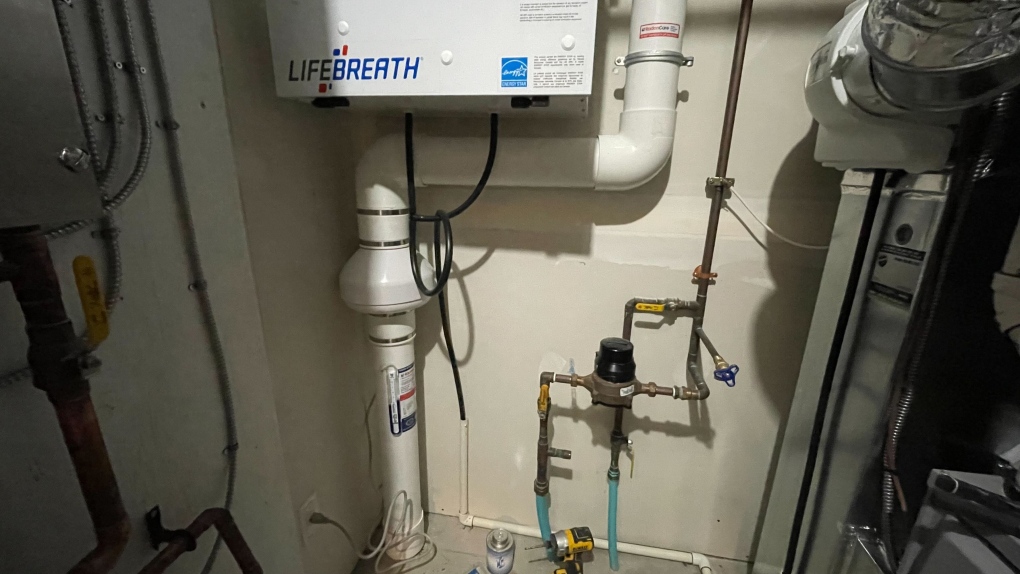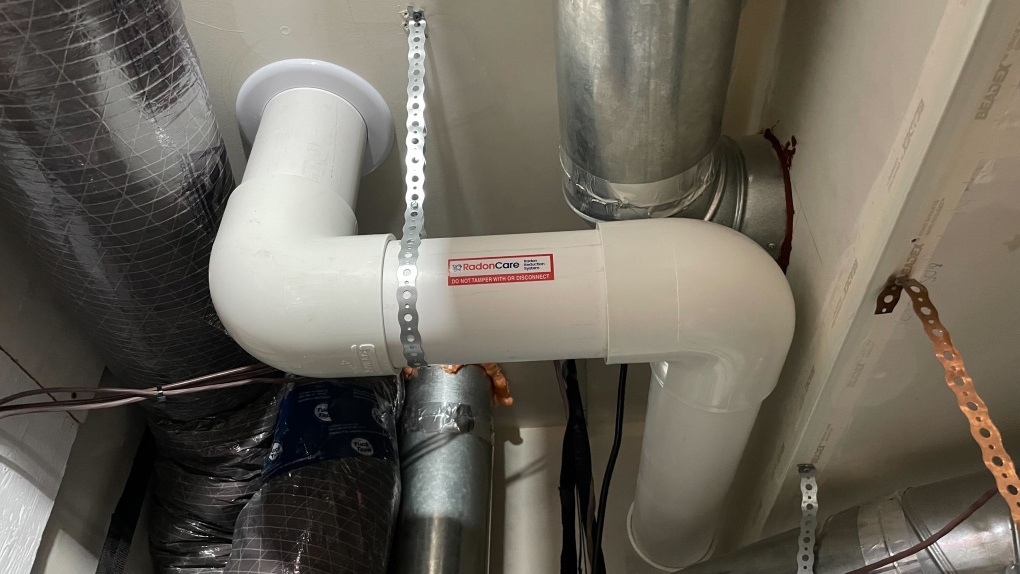'Radon exists everywhere': How to detect and keep the harmful gas out of your home
An invisible, odourless and harmful gas could be making its way into your home.
"Radon is a radioactive gas that comes from the decay of radium," said Andrew Arshinoff, the owner of RadonCare.
"Radon exists everywhere. It's inside, it's outside," he added.
When the gas builds up inside your home is the problem. According to Health Canada, one in five Canadian homes will have high radon levels, no matter the age or type of construction.
"Alberta is one of the highest places in the world," said Arshinoff, "Every neighbourhood in Alberta has at least one home that will test above the guideline."
People can test radon levels themselves. There are a variety of digital meters available, but Arshinoff warns it should be one approved by Health Canada.
"Some digital meters, be very careful if you're looking at those out there. Some are good. Some have been recalled by Health Canada. Make sure you do your research if you're going to pick one of those up," Arshinoff said.
Yugmel Nijjar lives in a basement suite in a home in Edmonton and has been tracking radon levels for years.
"I wanted to make sure I wasn't, putting myself at a significant risk of radon exposure," he said.
 A radon detector can be seen in this undated photograph. (CTV News Edmonton/Amanda Anderson)
A radon detector can be seen in this undated photograph. (CTV News Edmonton/Amanda Anderson)
It's recommended testing be done every three to five years because levels can change over time.
"They (the customer) measured ten years ago and the levels were low. Five years ago, it was still low. They measured recently and all of a sudden they were elevated," said Arshinoff.
It's also important levels be monitored for a minimum of 90 days.
"The levels in your home are going to go up one day and down the next so it's only the average over time that you want to take into consideration to know if there's a problem that you have to fix," Arshinoff said.
"Anytime you'd see it pop up above 150, you'd start thinking like should I be down here? Or should I be sleeping in this?," Nijjar said.
Radon is measured in becquerels per cubic metre, if the long-term average reading is more than 200 Health Canada recommends taking action.
"They do not say that under 200 is safe and over 200 is bad. Radon is a dose of radiation that you're going to get. And with radiation and the lower it is, the better it is," said Arshinoff.
Health Canada said radon is the leading cause of lung cancer in non-smokers and exposure kills more than 3,000 Canadians each year.
"Whenever we learn about lung cancer we learn about radon exposure and the risk of our own exposure being anywhere from five to 15 per cent worldwide causing lung cancers," said Nijjar.
Nijjar is about to start work as a radiation oncologist at the Cross Cancer Care Institute.
"Most lung cancers unfortunately people can live with them for quite a long time without even knowing it before they present to us," he said.
"Often times we would see patients that have symptoms of severe cough or maybe even coughing up blood but at that point usually this tumour has invaded into some critical structures or maybe it's spread to outside the lung," Nijjar added.
Despite the radon levels in his basement testing below the guideline, he opted to have a mitigation system installed.
Arshinoff's company installed it in November.
 A radon mitigation system can be seen in this undated photograph. (Amanda Anderson/CTV News Edmonton)
A radon mitigation system can be seen in this undated photograph. (Amanda Anderson/CTV News Edmonton)
"What happens is radon gas comes up from the earth. It comes up below the home. If it has nowhere to go it gets pulled into the basement," he said.
"This system here is designed to pull a little bit harder on the floor than the house is pulling on the floor so when the gas comes up it takes a new path of least resistance which is now to get pulled towards the system which vents it up and outside the house."
His company has installed mitigation systems in homes and commercial buildings – but there's one home that stands out.
Arshinoff got a call from a man in the Calgary area who said radon levels in his home were 20,000 becquerels.
"I said there's no way that's true. Your equipment is broken, you measured it the wrong way," he remembers telling the homeowner.
He said he went to the home to take readings himself.
"None of the equipment I had on the truck would even measure it. It just said high, meaning it was somewhere over 10,000," he said.
An addition was built on the home over an old well which is believed to be contributing to the elevated levels.
"When the barometric pressure goes down the radon goes up at the exact same time. So it is very much tied to the well in this house for the radon entry," said Arshinoff.
"The radon levels now upstairs are like 5 or 10 so the mitigation has taken care of everything," said Kurt Fisher, who owns the home.
 Piping for a radon mitigation system can be seen in this undated photograph. (Amanda Anderson/CTV News Edmonton)
Piping for a radon mitigation system can be seen in this undated photograph. (Amanda Anderson/CTV News Edmonton)
Arshinoff said making sure HRV systems are working properly and keeping fresh air intakes clear will help lower levels.
"Opening up a window will lower it. It's not exactly the most effective way to mitigate radon when it's -30°C outside," he said.
However, he said those are only short-term solutions.
"It does come back pretty quick," said Arshinoff.
He said houses built after 2016 are required to have a rough in for radon mitigation.
The cost to install a system varies but is typically below $3,500.
A cost some homeowners said is worth the peace of mind.
"Feel totally safe," said Fisher adding "We don't give it a second thought anymore."
"Everybody's lives are priceless so this is a small drop in the bucket compared to the rest of your life," said Nijjar.
CTVNews.ca Top Stories

Calgary woman stranded in Mexico after husband's death during diving trip
A Calgary woman is struggling to return home after her husband died while diving in Mexico, leaving her stranded and facing financial hardship.
Special national Liberal caucus meeting called for next week after regional chairs meet: sources
A special meeting of Prime Minister Justin Trudeau's national Liberal caucus has been called for next Wednesday, sources say.
'Inadmissible' foreign nationals to pay more upon return to Canada: CBSA
Foreign nationals who refuse or are unable to pay their own way home after being denied stay in Canada will soon face steeper financial penalties should they ever attempt to return.
N.S. community shocked by deaths of father, daughter; suspect was wanted in Toronto shooting
A Nova Scotia community is mourning the loss of two of its members after they were shot and killed in Halifax on New Year's Eve.
Sea and Himalayan salts recalled in Canada: 'Do not use, serve or distribute'
Two brands of sea and Himalayan salt are being recalled in Canada due to pieces of plastic found in the products.
Soldier who blew up Tesla at Trump hotel left note saying blast was to be a 'wakeup call' for the U.S.
A highly decorated Army soldier who fatally shot himself in a Tesla Cybertruck just before it blew up outside the Trump hotel in Las Vegas left notes saying the New Year's Day explosion was a stunt to serve as a “wakeup call” for the country’s ills, investigators said Friday.
'It's about time': Experts in Canada support call for warnings about cancer risk from alcohol
While Canada hasn't mandated cancer warnings for alcoholic beverages, a few experts are supporting a new push in the U.S. to have the labels on the products.
'Mystery volcano' that erupted and cooled Earth in 1831 has finally been identified
An unknown volcano erupted so explosively in 1831 that it cooled Earth's climate. Now, nearly 200 years later, scientists have identified the 'mystery volcano.'
Judge sets Trump's sentencing in hush money case for Jan. 10, but signals no jail time
In an extraordinary turn, a judge Friday set U.S. president-elect Donald Trump's sentencing in his hush money case for Jan. 10, but indicated he wouldn't be jailed.

































